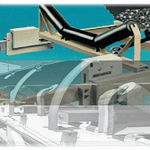BELT WEIGHER MAINTENANCE


It is important to remember that the entire conveyor that the belt scale is installed in become part of the “Weighing systems”, and that any changes that occur or are performed within this conveyor can and probably will affect the performance of the scale. Therefore, in addition to a routine scale maintenance procedure it becomes imperative that all maintenance performed on the conveyor be reported to the individual or department responsible for the scale’s performance.
What makes a Belt Weigher System: we have an answer?
A belt scale system consists of 3 elements:
- they weigh frame, which measures instantaneous mass,
- a tacho which measures belt speed, and
- the belt weigher electronics which integrate both these inputs to determine flow rate and totalised weight.

Belt Weighing systems (Belt Scales) are, however, much more accurate and must be maintained with much more care than a general instrument to achieve the accuracies which are necessary, typically 0.25% or 0.5%. As such, belt scales claim to be ‘weighing systems’ not general instruments and they do require quite a different mindset in their maintenance and care to achieve their promised accuracies. The calibration of a belt scale can be established by independently calibrating the weigh frame and the tachometer or the complete system can be calibrated with a test load of real material often termed a ‘live load’.
The role of ElenTech Resources belt weigher electronics set has grown considerably since the early days of belt weighing. Now one of the most important roles of the electronics set is to make calibration and maintenance of the belt weighing systems easier and more accurate.
Zero Setting
- The zero setting is how we subtract off this ever present but irrelevant weight so that only the weight of actual travelling material is measured.
ElenTech Resources recommends Maintenance Check List chart. Note that verification of the basic mechanics of the conveyor system itself is an integral part of the scale maintenance procedure. If you have any question regarding your Belt Weigher, please do not hesitate to contact ElenTech Resources office for service assistance
